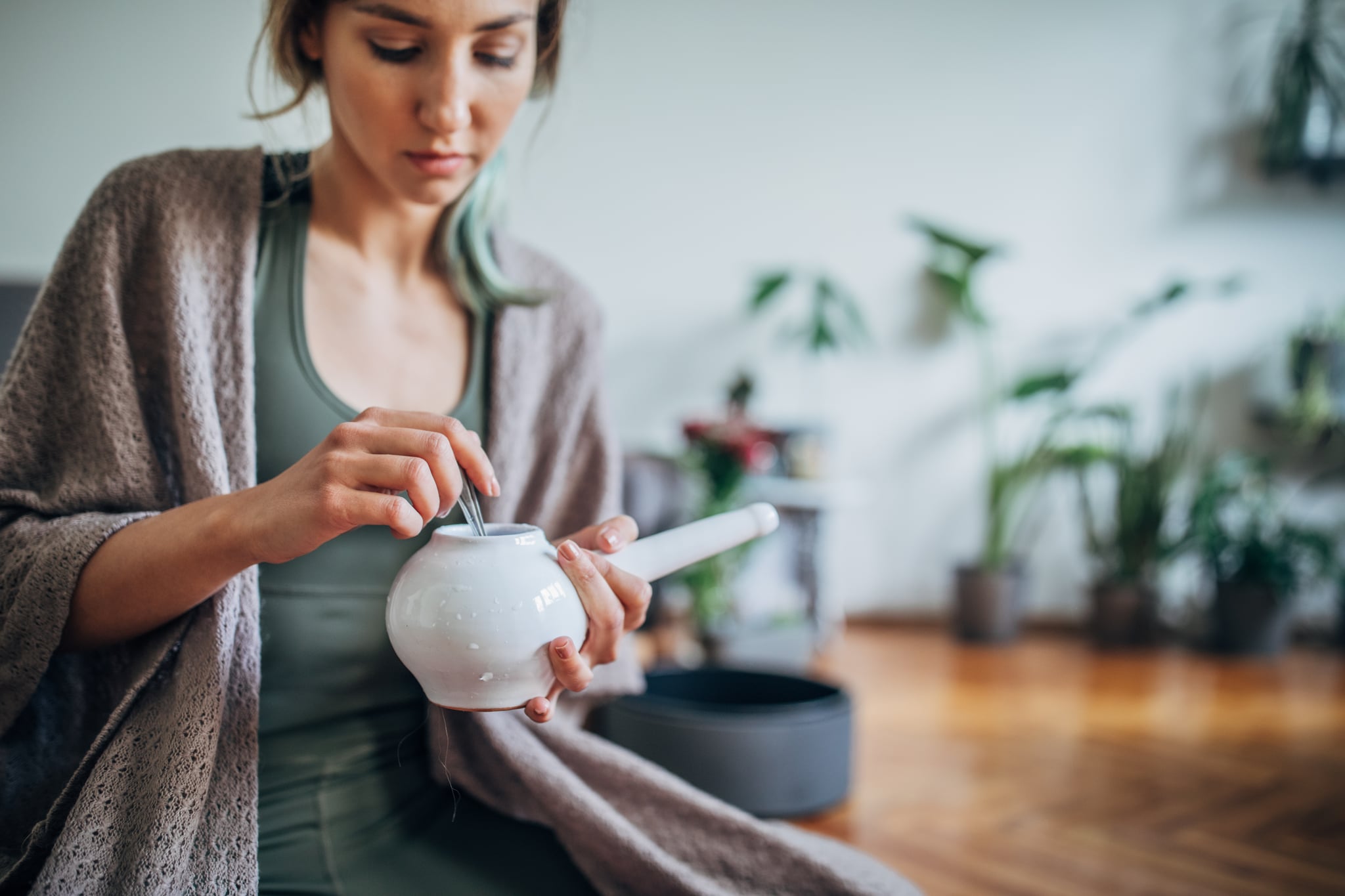Having clogged, stuffy sinuses is hardly a picnic, which is why plenty of people turn to Neti pots to help clear things out. But nasal irrigation at home is a little tricky if you’ve never done it before — and that can leave you wondering how to use a neti pot.
A neti pot, in case you’re not familiar with it, is a ceramic or plastic container that’s usually shaped like a teapot or oil lamp, says Benjamin Bleier, MD, an ear, nose, and throat surgeon at Massachusetts Eye and Ear and associate professor of Otolaryngology–Head and Neck Surgery at Harvard Medical School. “It’s designed to flush the nasal cavity with typically a salt water solution by the force of gravity,” he explains. With a neti pot, water flows into one nostril and out the other, rinsing mucus and gunk from your nose and sinuses — the air-filled space behind your cheeks and nose — in the process.
Even if you’re familiar on some level with neti pots already, there are some factors to be aware of, like how often to use a neti pot, the best time of day to use a neti pot, and potential neti pot side effects. There are also potential sinus rinse dangers to have in mind before you dive in.
Overall, doctors say it’s a good idea to have a neti pot in your home. “There is a lot of evidence to support regular neti pot use,” says Michael Yong, MD, an otolaryngologist (ENT) and neurorhinologist at Pacific Neuroscience Institute in Santa Monica. Here’s what you need to know about rinsing your sinuses, plus the right way to do it.
How to Use a Neti Pot
It’s important to review the instructions that come with your neti pot before using it. If you happened to throw out the box, Dr. Bleier provided a step-by-step guide for how to use most neti pots:
- Fill your pot with distilled, sterile, or boiled and then cooled water (more on why that’s important in a moment).
- Lean over a sink, tilt your head sideways, aiming to have your forehead and chin be level.
- Open your mouth and breath through it.
- Insert the spout into the upper nostril, letting the liquid drain through to your lower nostril.
- Then, repeat the same thing on the other side.
In terms of the best time to use a neti pot, doctors say there’s really no optimal time. But Dr. Yong says he usually recommends his patients do it in the morning and evening.
“The best time of day is the time of day you’ll remember to use it,” Dr. Bleier says. “Individuals should play with it and test it out.” As a heads up though, some people find that using a neti pot before bed raises the odds they’ll have fluid drainage at night, says Dr. Bleir — which may be worth considering.
Sinus Rinse Dangers
There are a few things to be mindful of when doing a sinus rinse. A big one is potential contamination. The reason you should only rinse with distilled, sterile, or previously boiled water is that tap water can contain low levels of organisms you don’t want in your nose, like bacteria and amoebas that can cause potentially serious — and in rare cases, deadly—infections, Dr. Yong says. Distilled, sterile, or previously boiled water, “have eliminated microorganisms that can live in the water,” he explains.
The bottle itself can also get contaminated, which is why Dr. Bleier recommends cleaning it with hot, soapy water in between uses. “We know that bacteria can colonize the walls of the bottle, even within one use,” he says. “Some are dishwasher safe — you have to check the label.”
Neti Pot Side Effects
As with nearly everything, there are some potential side effects that can come with using a neti pot. On a more minor level, if your forehead and chin aren’t level when you use the neti pot, you run the risk of getting gunky water into your mouth during your rinse.
Some people can also get fluid into their eustachian tubes, which connect the middle ears to the back of your nose and throat, Dr. Bleier says. “When irrigating, make a ‘K’ sound,” he says. “It brings the soft palate up and covers the eustachian tube.”
It’s also possible to feel some pressure or even develop a headache when you do nasal irrigation, per Dr. Bleir. “If that’s the case, modify the pressure or stop it altogether,” he says.
The temperature of your water can make a difference in how you feel, too. “Sometimes it can cause discomfort if the water is too cool,” Dr. Bleier says. “Slightly warm water is often more comfortable.”
How Often to Use a Neti Pot
This is up to you. “There’s no upper limit on what is considered safe or not safe,” Dr. Bleier says. “On average, we recommend doing it one to two times a day.” Dr. Yong also says that he has some patients who will irritate up to four or five times a day.
Just keep tabs on how you feel when you’re doing this. “If you use it really excessively, it can have the opposite effect and dry out the nose,” per Dr. Yong.
